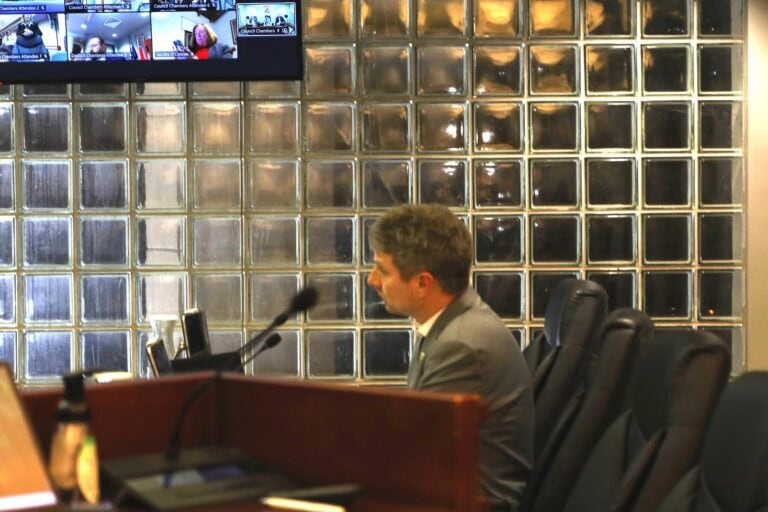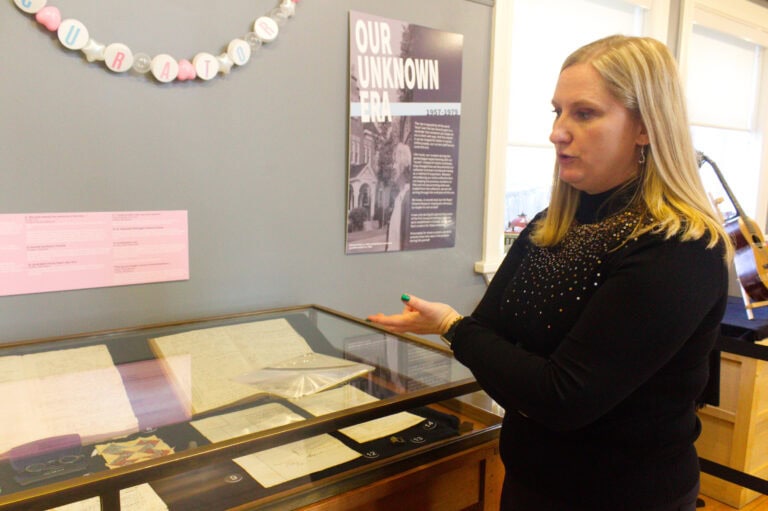The water level in Lake Ontario is not expected match the record high of 2019, according to Brett Ruck, environmental services supervisor for the Town of Niagara-on-the-Lake.
But things could change.
“I know some of the forecasts right now are that the water levels aren’t going to go as high, however the government has said that in the past and actually hasn’t been the case,” Ruck said in an interview with The Lake Report Monday.
“So we’re not letting our guard down until we feel comfortable ourselves that water levels aren’t going to reach the 2018 or (2019) levels.”
For now, town staff are keeping an eye on the situation, monitoring the Niagara River level twice a week.
“When (the water gets) up to a certain point, that’s going to trigger us to bring in the pumps, just so that we can keep the ditches and everything clear in case of storm events,” Ruck said.
Ron Simkus, a dock area resident who prepares a weekly report on lake levels, said he’s confident the town will be able to manage any flooding this year.
“This year is shaping up to be a year where we probably will get through without any kind of disaster,” he said.
Simkus said the big three things that come into play with Lake Ontario levels are the Niagara River, the Ottawa River and rain.
“Any combination of two of those three is what causes the lake level to go up,” he said.
The Ottawa River Regulation Planning Board has been issuing daily reports on the status of the Ottawa River, which Simkus includes in his report.
“The Ottawa (River) is doing much better this year than it did last year,” Simkus said. “Last year it really surprised everybody and went into a late spring thaw, with a huge snow pack, and, of course, it started to flood Gatineau and Montreal and that ended up backing everything up here into Lake Ontario.”
That’s not the case this year. “The snow pack’s not as big, the spring is cool and slowly melting and all of the reservoirs in the Ottawa River Basin seem to be well in control and they feel confident they’ll manage it properly this year,” he said.
He called 2019 a “perfect storm” for high water in Lake Ontario.
“Last year the Ottawa (River) came into play in a big way, the Niagara River was extremely record high levels, and then it rained, so we actually got the perfect storm of three events happening at the same time,” Simkus said.
“This year at least the Ottawa (River) is out of play. And what’s really shaping up to be beneficial is the weather has been cool and relatively dry, so that’s dampened the pressure on Lake Ontario.”
The one thing that’s a constant this year, and is going to leave us with high levels all year, is the Niagara River, he said.
“All the lakes upstream of us, especially Michigan and Huron and Superior, are still way, way above their average levels, and that’s not going to go away soon. I think that we’ll see the Niagara River flowing at record levels all year and probably going into next year as well,” Simkus said.
Simkus said last year he had to pump a lot of water from his basement, but was fortunate compared to some neighbours.
“The lake level basically brings the water table under my house up,” he said. “But unlike most of my neighbours, we did quite well last year.”
Simkus said we’re fortunate on Lake Ontario that levels can be somewhat controlled by the Moses-Saunders Dam near Cornwall.
Flooding is much worse for people on Lake Superior, Michigan and Huron, because those lake levels can't be controlled at all, he said.
“Here in Lake Ontario, you’ve got the dam, and we’re the only lake that has a level that’s controlled by man,” he said.
“That’s the one thing that is really quite controversial this year, is the fact that people criticized the International Joint Commission for mismanaging the Moses-Saunders Dam in Mecina, New York.”
A 2014 plan for managing the dam went into effect Jan. 1, 2017, the first year of a “disastrous flood,” Simkus said.
“And then we had a repeat in 2019, so everybody said it had to have something to do with the way they were running the dam. And now the IJC has completely abandoned all of their regulation plans and they’re running everything on a day-to-day basis with the purpose of keeping the level of Lake Ontario down. And they’re adamant that there’s no regulation plan that would work, and they have to basically manage it manually.”
The IJC has “broken all records” this year when it comes to getting water out of Lake Ontario.
“Of course, they’re victims of their own success because people are saying, ‘Well, if you had done this before, it wouldn’t have been as bad,’ and they’re saying, ‘Well no, we’re doing the best we can with the situation we have. If you repeated the weather we had last year we’d still be in big trouble no matter what we try to do.’ ”
The town has measures in place to prevent heavy flooding, Ruck said, such as one-way check valves on the inside of the sewer systems, so when the water pressure on the riverside becomes greater than the pressure going out, they won’t open.
“That’s the point of needing the pump,” Ruck said.
“When the river starts getting up to the point where it’s spilling over and crashing over the erosion protection we have there now, we do have tiger dams that we can set up in different locations to keep the water back,” Ruck said.
The town will also continue work on the trail near Ball's Beach, though COVID-19 will affect the park work, he said.
“It’s just going to slow down, but once we get to a point that’s critical, we’ll just be protecting what we can where we can, just like we have in the past,” Ruck said.
Another project that also could be affected by COVID-19 is a stone groyne, which has been in the works for a few years.
“We had planned, as in the past, to get those stones put in, but we found out just before winter that there’s a void in the river and we have got to fill the void so that we can put the stones on top. So it’s going to require some additional funds,” Ruck said.
“We are still going to continue to do the groyne, as long as council is approving that. Again that may be affected by the COVID-19, but that’ll be a council decision when we get closer to the time. We can’t go in the water before July 15 anyhow due to water-timing restrictions, so we still have a little time before we do anything. The plans are already done, we know what we need to do, we’ve just got to get in there to do it, and that’s just funding,” Ruck said.
The void is to the north of the historic culvert near Ball’s Beach. “It’s just off the sout-eastern tip of that groyne,” he said.
He said the void could have been cause from ice in previous years.
“It just hasn’t recovered filling in the banks, so we’re going to give it a little assistance and fill it in.”
Work on the groyne is restricted by fish spawning times, said Simkus.
“You can only work in the water here when the fish aren’t spawning,” he said. “So, for instance, from March 1 until July 1, you can’t set your foot in the water. Then from September to November, again you can’t go in the water.”
He said the idea of the town getting the work done in July is “impractical” because of the potential tourist season and that the town was “holding out a candle” for funding, which will likely be impacted by COVID-19.
“Personally, I think they’re going to be disappointed because I think both the Ontario and federal governments have blown their brains out. They have no money to spare and their priorities are going to be the major centres like Toronto and the GTA for Ontario, for sure. So we’re going to be poor sisters in this whole kind of money disbursement thing.”
He said there’s work that needs to be done all along the river, at the dock area, the jet boats and the Pumphouse.
“All those three projects add up to millions,” Simkus said. “And they don’t have millions of dollars.”
He said when town council makes a decision, dock area residents would like to be informed.
“Right now when things happen down here it’s just like, ‘Surprise, we’re here,’ ” he said. “It would be nice to let us know when you’re going to do something.”
Simkus said dock area residents are nervous about this year. “Some of them have done some extra work to prepare.”
“For the people who live more inland, they were more concerned about flooding, and that seems to be not as serious an issue, so they’re not as nervous. The people who still have to be cautious are the ones who live right on the water’s edge, because the lake levels will be high and they’ll be high all summer.”
He said if there are summer storms, there will be issues with wave damage.
Ruck said he’s really hoping the lake levels won’t rise as much as it did in 2019.
“Those models have been consistent over the number of years. And as Ron says in his document, we can only hope that those projections are going to be the case. I mean when you look at Lake Superior right now, we know that they still have lots of snow up there. They’re just starting to get into the melt and it’s coming down quickly. So if the waters are going to rise, they’re going to rise quickly as it melts up north and we’ll see how accurate the models are once the north has thawed out.”
“I find this year we’re going to plan for the same type of situation that we did in 2019. If levels are low, great. I’d rather be in that situation than if what levels they were mentioning are going to go higher. So we have done some modelling and stuff to see what’s going to happen if it does go higher, and if we do breach. So we’re feeling as confident as we did in the last couple of years, to be able to protect and maintain the shoreline as we have in the past,” Ruck said.
He said the information on lake level forecast is coming from Environment Canada.



.jpg)







